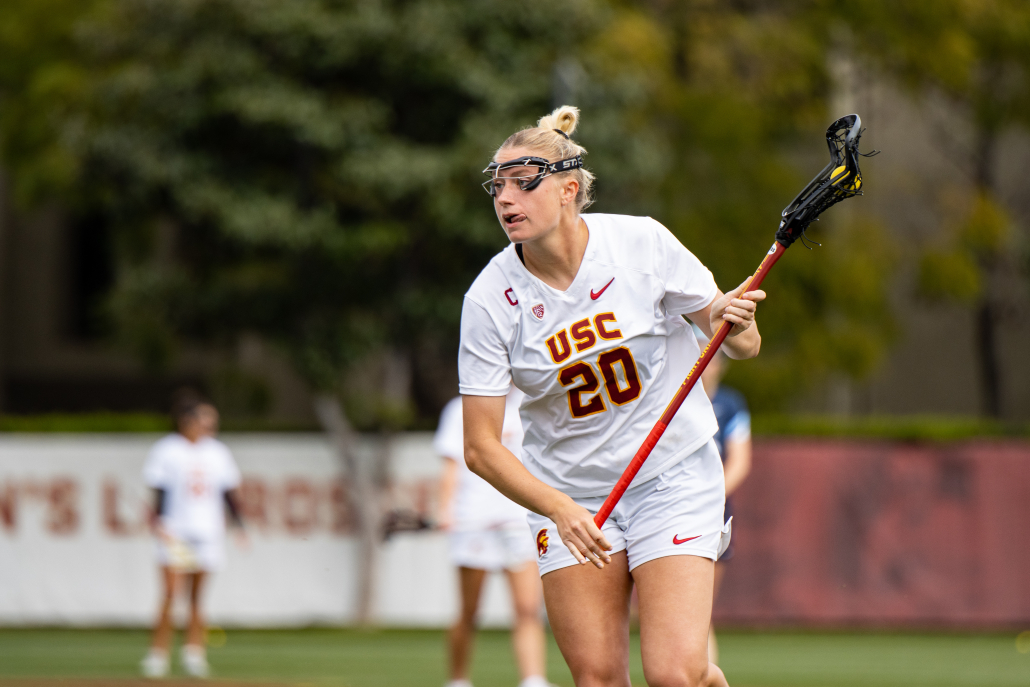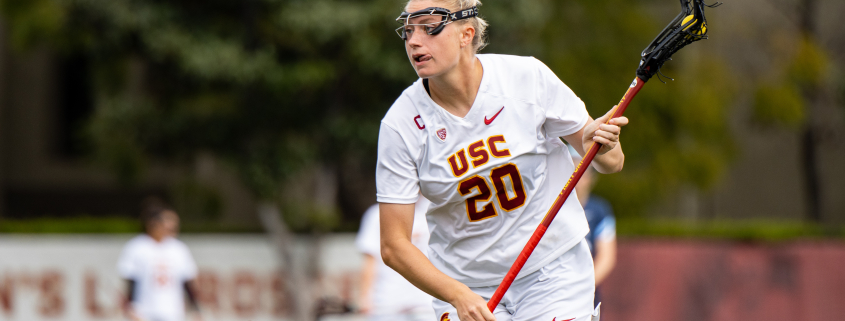Heart to Heart: How women will bring lacrosse to the West Coast

Uncertainty, ironically, is what steers the course of our lives from the very beginning. It is human nature to question everything, to try to peer around every blind curve at each fork in the road and to find the “why” in everything that we do. In most cases, that “why” presents itself after all the real work has been done, and there’s no going back.
For graduate lacrosse midfielder Katie Ramsay, her “why” is finally coming into view after half a decade of playing a collegiate sport she never intended on falling in love with.
Ramsay committed to USC after attending a lacrosse camp early in high school and quickly became enraptured by the program. However, lacrosse was not always her end-all-be-all sport growing up.
“I am from the East Coast, which is obviously a lacrosse hotspot, so I think I started lacrosse when I was in second or third grade,” Ramsay said. “[I] never really loved it. I always wanted to go to college for soccer.”
The transition from soccer to lacrosse was a first glimpse at uncertainty around collegiate athletics for Ramsay. TheLos Angeles sun was just one reason that Ramsay took the path that she did in the aforementioned fork in the road, which led her to play at USC.
“I just fell in love with the environment of the people out here, and for the first time really felt myself having fun playing lacrosse,” Ramsay said. “Through high school, I just looked forward to coming here and playing and it’s really lived up to all of it … I couldn’t ask for anything more.”
For many student athletes, their years of playing in college are what wrap up their time in the spotlight. For Ramsay, however, playing lacrosse at USC is just the beginning of her love for the sport.
“I never really thought it would become such a big part of my identity and who I am today,” Ramsay said. “I don’t think I would be who I am without the girls I surround myself with [and] the coaches that have taught me everything I know.”
In any team sport, the squad as a whole, as one unit, is what makes seasons successful. We see this attitude that there is no “I” in “team” in women’s sports, in particular. The success of individual women on the field is only further expounded upon when surrounded by similarly fierce teammates. This energy is just one of the many reasons why women’s athletics are so fun to watch. The team dynamic is easy to support — not just one star player carrying the team on their back.
Lacrosse is an especially good example of this aspect of teamwork, as the sport is still in its growing stages on the West Coast. Players across cities and states on this side of the country play on one, huge team working toward the spread of the sport, whether they realize it or not.
“I think a lot of what makes this team special is everyone committed here wanting to grow the game,” Ramsay said. “It’s a special group of girls that has that passion for growing the game, and it’s been cool to see local high schools, local middle school girls come to our games and get so excited.”
If you’re lucky enough to say that sports found you at a young age — whether through grueling nights in the bleachers watching an older sibling or a fly ball that almost hit your three-month-old head at a Giants game back in ’03 — you understand the importance of having role models
in athletics as a child. For local kids, especially young girls with fewer people pushing them to play, collegiate athletes can be the perfect gateway drug into the addiction that is sports.
This is just one of the many “whys” that Ramsay has found through lacrosse at USC. Her journey across the country enabled her to lead the charge in lacrosse’s own migration west. This power, however, also puts a lot of pressure on Ramsay; as her final games close out, so does her ability to make an impact at the collegiate level.
“My main pressure that I’m feeling — this year especially — is the fear that this is my last year,” Ramsay said. “I think being a woman playing college sports is kind of like that last level. There is professional women’s lacrosse … but it’s not really a huge thing.”
Women’s sports in college present unique challenges for playing after graduation. Professional leagues are few and far between for sports like lacrosse, and for players like Ramsay, the final moments of a nearly lifelong career are bittersweet.
“It’s definitely that last opportunity to prove to myself what I can do and what I can be,” Ramsay said. “I’ve been trying to not let that get to me, but just use it to fuel me and get me pumped up for every single game because it could be the last opportunity.”
With the end of one journey comes the beginning of many others. Ramsay’s commitment to the game thousands of miles away from its epicenter will only act as an aid in its westward dispersion. For the next generation of young women, representation at the highest level is the most impactful marketing method for the sport.
“It’s just important for young girls to see themselves in media and on TV and be able to imagine themselves in these positions for when they grow up,” Ramsay said.
Ramsay’s advice for young lacrosse players emerged after a period of intense pressure that led to some unsatisfactory seasons for the midfielder. Her second, third and fourth seasons of college lacrosse showed that increased pressure doesn’t always warrant prime results.
“I put so much pressure on myself to compete at that level again, and it just kind of made me play worse,” Ramsay said. “This year I’ve really been focusing on just having fun, playing loose and just enjoying the sport.”
Ramsay’s renewed focus goes back to why humans get excited about sports so easily: the competition, the energy, the uncertainty of every moment and, of course, the love of the game.
“Lead with kindness, lead with love,” Ramsay said. “That’s my motto.”
Dana Hammerstrom is a sophomore writing about the mental health of collegiate athletes, as well as the emotional pressures they face in her column “Heart to Heart.”

